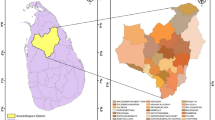Abstract
Desertification has been a global concern long ago. However, it has never been as severe as it is in the present day. According to the United Nations Convention to Combat Desertification (UNCCD), almost one-third of the world’s agricultural land is facing one form of degradation or another. Assessment of desertification using GIS nowadays presents an efficient means for identifying desertification vulnerable areas. Henceforth, this study aimed to assess desertification vulnerability in Kebbi State, Nigeria, by using Mediterranean desertification and land use-environmental sensitivity area index (MEDALUS-ESAI) approach. The approach is based on biophysical and human indicators. The characteristics and intensity of these indicators contribute to the evolution of different levels of desertification. For the desertification sensitivity index (DSI), quality indexes, and the corresponding individual indicators, a weighted sensitivity score was assigned from 1 to 2. The resultant index layers were merged for generating the DSI theme. The distribution of the DSI indicated that 36% of the area is not affected, and 17% and 30% fall into low and moderately sensitive classes, while 15% and 1% of the area are classified as sensitive and highly sensitive respectively. The result, therefore, indicated that the area is moderately sensitive to desertification. DSI is essentially useful for determining desertification severity. The theme will contribute significantly to the decision-making process most importantly in the selection of priority zones in combating the desertification phenomenon in the area. This study delineates the potential desertification vulnerable areas that need urgent action; the model is thus recommendable for its flexibility and accuracy.





Similar content being viewed by others
References
Adeel Z, Safriel U, Niemeijer D & White R (2005) Ecosystems and human well-being: desertification synthesis. (Sarukhán J & Whyte A Eds.). Washington DC: World Resources Institute
Alim M, & Mumuli SO (2010) Practical guide for land degradation monitoring. FAO-SWALIM. Project Report No. L-20. Nairobi
Allen RG, Pereira LS, Raes D, & Smith M (1998) Crop evapotranspiration - guidelines for computing crop water requirements - FAO Irrigation and drainage paper 56. Rome
Avdan U, & Jovanovska G (2016) Algorithm for automated mapping of land surface temperature using LANDSAT 8 Satellite Data. J Sens
Ayuba NMGHK (2016) On major environmental problems of desertification in northern Nigeria with sustainable effort to managing it. World J Sci Technol Sustain Dev 13(1)
Basso F, Bove E, Dumontet S, Ferrara A, Pisante M, Quaranta G, Taberner M (2000) Evaluating environmental sensitivity at the basin scale through the use of geographic information systems and remotely sensed data: an example covering the Agri basin (Southern Italy)1. CATENA 40(1):19–35
Contador LJF, Schnabel S, Gutiérrez GA, Fernández MP (2009) Mapping sensitivity to land degradation in extremadura. SN Spain Land Degrad Dev 20:129–144
FGN (2015) Federal Government of Nigeria: National Human Development Report: Human Security and Human Development in Nigeria. Abuja
Idris Medugu N, Rafee Majid M, Johar F (2011) Drought and desertification management in arid and semi-arid zones of Northern Nigeria. Manag Environ Qual Int J 22(5):595–611
Kapalanga TS (2008) A review of land degradation assessment methods. Land Restoration Training Programme. Agricultural University of Iceland
Kosmas C, Kirkby M, & Geeson N (1999) MEDALUS Project: Mediterranean desertification and land use. Manual on key indicators of desertification and mapping environmentally sensitive areas. Luxembourg. Retrieved from http://www.medalus.demon.co.uk/. Accessed 16 June 2016
Li J, Heap AD (2011) A review of comparative studies of spatial interpolation methods in environmental sciences: performance and impact factors. Eco Inform 6(3–4):228–241
NBS (2012) Federal Republic of Nigeria: Annual Abstract of Statistics, Annual Abstract of Statistics. Abuja. Retrieved from www.nigerianstat.gov.ng. Accessed 18 March 2016
Ogungbenro SB, Morakinyo TE (2014) Rainfall distribution and change detection across climatic zones in Nigeria. Weather Clim Extremes 5(1):1–6
Olagunju TE (2015) Drought, desertification and the Nigerian environment: a review. J Ecol Nat Environ 7(10):256–262
Raul P-H, & Koohafkan P (2004) Methodological framework for land degradation assessment in drylands. Food and Agriculture Organization of the United Nations, Land and Water Development Division. Rome
Safriel U (2009) Deserts and desertification: challenges but also opportunities. Land Degrad Dev 20:587–588
Sameen MI, Ahmed M, Kubaisy A (2014) Automatic surface temperature mapping in ArcGIS using Landsat-8 TIRS and ENVI Tools case study : Al Habbaniyah Lake. J Environ Earth Sci 4(12):12–18
Symeonakis E, Karathanasis N, Koukoulas S, Panagopoulos G (2016) Monitoring sensitivity to land degradation and desertification with the environmentally sensitive area index: the case of Lesvos Island. Land Degrad Dev 27(6):1562–1573
UNCCD (2007) Climate change and desertifcation: thematic fact sheet series. Bone, Germany
UNCCD (2008) Climate change in the African dry lands: options and opportunities for adaptation and mitigation. Nairobi, Kenya
Usman S, Sani Noma S, Kudiri AM (2016) Dynamic surface soil components of land and vegetation types in Kebbi State Nigeria. Eur J Soil Sci 5(2):113–120
Yao X, Fu B, Lu Y, Sun F, Wang S et al (2013) Comparison of four spatial interpolation methods for estimating soil moisture in a complex terrain catchment. PLoS ONE 8(1):e54660
Acknowledgements
The authors wish to thank the anonymous referees for their valuable comments. The authors also wish to acknowledge the USGS, NPC, and CGIAR-CSIGeoPortal for making data freely available not only for this project but other of its kind.
Funding
This research was funded by the Tertiary Education Trust Funds (TETFund) of Nigeria through Kebbi State University of Science and Technology, Aliero.
Author information
Authors and Affiliations
Corresponding author
Ethics declarations
Conflict of interest
The authors declare no competing interests.
Rights and permissions
About this article
Cite this article
Aliero, M.M., Ismail, M.H., Alias, M.A. et al. Geospatial analysis of desertification vulnerability using Mediterranean desertification and land use (MEDALUS) model in Kebbi State, Nigeria. Appl Geomat 13, 527–536 (2021). https://doi.org/10.1007/s12518-021-00372-5
Received:
Accepted:
Published:
Issue Date:
DOI: https://doi.org/10.1007/s12518-021-00372-5




